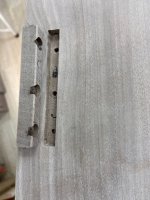- Messages
- 11,635
- Location
- Constantine, MI
You’re always welcome!You have to ship these to California correct? THAT is scary! Just might need to make a little trip south and see those before shipping. Really looking good Rennie
You’re always welcome!You have to ship these to California correct? THAT is scary! Just might need to make a little trip south and see those before shipping. Really looking good Rennie
Thanks!Same here Tom..being here in TX, I will have to get by with photos.
Rennie..the crown really looks good.
Nailed it? Nah...I'm pretty sure he said he used screws.+1 on the crown proportions; nailed it.

I don't know if Gustav, Charles and Henry would approve, but the crown is held together with three pocket hole screws at each corner. Then it is installed as a unit and screwed in from the back to a supporting structure with 5 screws. Someday, some less-than-bright person will move this by holding on to the crown. I want to make sure it survives.Nailed it? Nah...I'm pretty sure he said he used screws.

Since screws seemed to be good enough for Sam Maloof, I doubt the Greenes would object too strongly.I don't know if Gustav, Charles and Henry would approve, but the crown is held together with three pocket hole screws at each corner. Then it is installed as a unit and screwed in from the back to a supporting structure with 5 screws. Someday, some less-than-bright person will move this by holding on to the crown. I want to make sure it survives.


When I took the class with Sam he said that a screw was nothing more than a dowel made of steel.Since screws seemed to be good enough for Sam Maloof, I doubt the Greenes would object too strongly.
More nerd stuff:I guess it is all a moot point as pocket hole joinery has been around for well over 100 years, at least.
That far back? Wow!It is my understanding that nails were used in furniture making LONG before I was born.
There was furniture then!?!It is my understanding that nails were used in furniture making LONG before I was born.
You are a wise fellow. A sage among us.I think that Greene and Greene, Stickley, Morris and certainly Sam would all use what ever mean of fastening they deemed appropriate for the task as long as it did not detract from the piece and that would include pocket screws. I remember when I took the class with Maloof he was shaping an arm rest for a chair using a rasp. Someone asked him if he ever used a spoke shave and he went over to the tool cabinet and got one out. went back to the task and after taking a few swipes put it down and went back to the rasp and said it was too slow. Then he went on to say that there is no right or wrong tool use whatever one you are most comfortable. I think they would all say the same thing about fasteners.
that's interesting, I noticed some time back while sitting on the throne that the screws holding the switch plate in the bathroom were all straight up and down so I looked over at the plug by the sink and sure enough they too were straight up and down so when I finished my business I went around the house and sure enough the screws on every cover plate in the house were straight up and down, I found it interesting that the electrician who wired this house took that much pride in his work to pay attention to those little details.Nails and screws are just a different kind of hardware if I may say so, we use them to fix hinges, door knobs, metal feet or casters, so, whay shouldn't they be used to fasten other parts of the furniture?
I do not know there in US, but here, the signature of a good cabinet maker (apart from his craftsmanship) was to aling the slots of the screw heads that could be seen in hinges or key escutcheons for instance. Unfortunately this attention to detail has been lost, first because of the implantation of Philips screws, and what is more sad, is that good cabinet makers are more and more scarce and even less apprentices.

